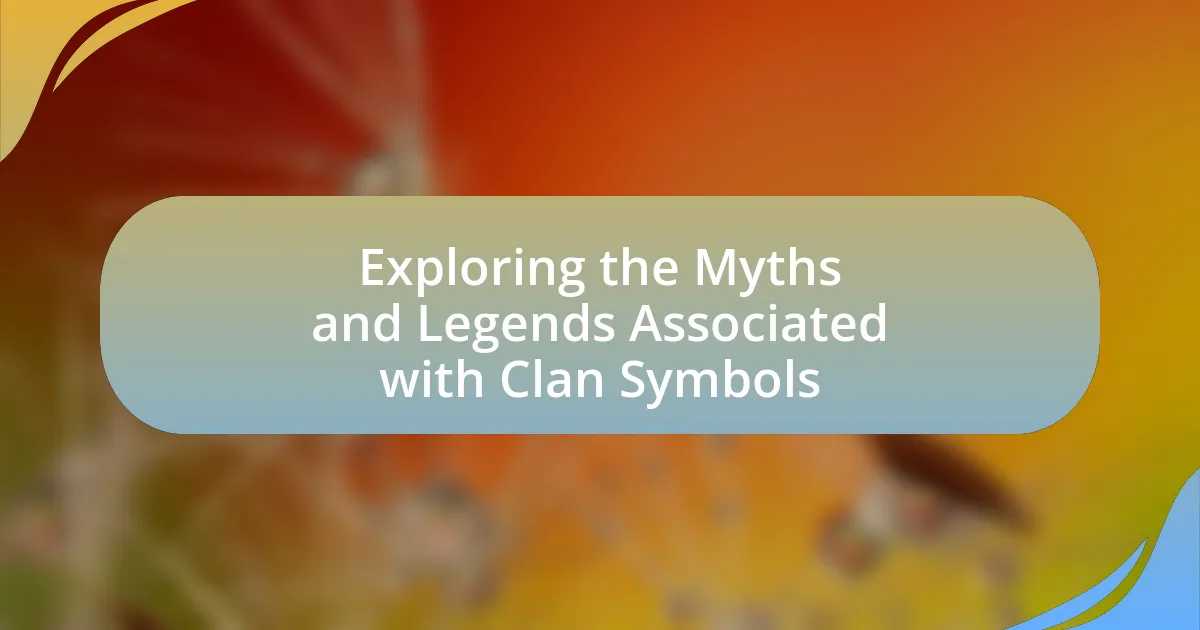The article focuses on famous Scottish clans, including the MacLeods, Campbells, and MacKenzies, and their distinctive tartans, which serve as visual identifiers of clan heritage. It explores the origins of tartan traditions, their historical significance, and how they symbolize clan identity and cultural pride. The piece also discusses the impact of historical events on tartan development, the process of tartan registration, and best practices for wearing and displaying tartans at events. Additionally, it highlights the unique characteristics of various clan tartans and their role in modern Scottish celebrations.

What are Famous Clans and Their Distinctive Tartans?
Famous clans in Scotland include the MacLeods, Campbells, and MacKenzies, each associated with distinctive tartans. The MacLeod tartan features a bold yellow and black pattern, symbolizing the clan’s heritage from the Isle of Skye. The Campbell tartan is characterized by a green and blue checkered design, representing the clan’s historical significance in Argyll. The MacKenzie tartan showcases a rich green and blue pattern, reflecting the clan’s roots in the Highlands. These tartans serve as visual identifiers of the clans, with each pattern steeped in history and tradition.
How did the tradition of tartans originate among Scottish clans?
The tradition of tartans among Scottish clans originated as a means of identification and representation of clan heritage. Historically, different patterns and colors of tartan were associated with specific clans, allowing members to recognize each other, especially during conflicts or gatherings. The use of tartans became more formalized in the 18th century when the Scottish Act of Parliament in 1746 banned the wearing of tartan as a means of suppressing Scottish culture, which ironically led to a resurgence in its popularity as a symbol of Scottish identity. This cultural significance was further solidified by the publication of “The Scottish Tartan” in the early 19th century, which documented various clan patterns, thus establishing a lasting tradition.
What historical events influenced the development of tartans?
The development of tartans was significantly influenced by historical events such as the Jacobite uprisings in the 17th and 18th centuries. These uprisings, particularly the 1745 rebellion led by Charles Edward Stuart, fostered a sense of Scottish identity and nationalism, which in turn popularized the use of specific tartans associated with various clans. The subsequent Dress Act of 1746, which banned the wearing of tartan, further solidified its cultural significance; after its repeal in 1782, tartans became symbols of Scottish heritage and pride. The Highland Clearances in the 18th and 19th centuries also played a role, as displaced clansmen sought to preserve their cultural identity through tartan patterns.
How do tartans symbolize clan identity?
Tartans symbolize clan identity by serving as unique patterns that represent specific Scottish clans, each with its own distinct colors and designs. These patterns historically indicated allegiance and heritage, allowing individuals to visually express their clan affiliation. For example, the MacLeod tartan features a distinctive yellow and black pattern, which signifies the MacLeod clan’s identity and lineage. The use of tartans dates back to the 16th century, when they became associated with particular clans, reinforcing social bonds and cultural identity among members.
What role do tartans play in Scottish culture?
Tartans serve as a significant symbol of Scottish identity and heritage, representing various clans and families. Each tartan pattern is unique to a specific clan, allowing individuals to express their lineage and cultural pride. Historically, tartans were used in clothing and textiles, with the earliest documented use dating back to the 16th century, when they became associated with Scottish Highland clans. The Scottish Tartan Act of 1815 further solidified the importance of tartans by regulating their use and promoting their cultural significance. Today, tartans are prominently featured in Scottish ceremonies, festivals, and national celebrations, reinforcing their role as a vital element of Scottish culture.
Why are tartans considered a form of heritage?
Tartans are considered a form of heritage because they represent the cultural identity and history of Scottish clans. Each tartan pattern is associated with a specific clan, symbolizing lineage, tradition, and community ties. Historically, tartans were used to distinguish different clans and regions in Scotland, with unique patterns developed over centuries. For example, the MacGregor tartan is linked to the MacGregor clan, showcasing their distinct identity. This connection to ancestry and cultural practices reinforces the significance of tartans as a vital aspect of Scottish heritage.
How are tartans used in modern Scottish celebrations?
Tartans are prominently featured in modern Scottish celebrations as symbols of heritage and identity. During events such as weddings, Highland games, and festivals, individuals often wear kilts made from specific tartan patterns that represent their clan or family lineage. This practice not only showcases personal and familial pride but also fosters a sense of community among those sharing the same tartan. For instance, the Royal Stewart tartan is widely recognized and worn during national celebrations, reinforcing its status as a symbol of Scotland itself.

Which Famous Clans are Associated with Distinctive Tartans?
Famous clans associated with distinctive tartans include the MacGregor, Campbell, and MacLeod clans. The MacGregor tartan is recognized for its rich history and vibrant colors, while the Campbell tartan is known for its dark green and blue hues, symbolizing the clan’s heritage. The MacLeod tartan features a striking yellow and black pattern, representing the clan’s identity. Each of these clans has a unique tartan that reflects their lineage and cultural significance in Scottish history.
What are the most recognized Scottish clans and their tartans?
The most recognized Scottish clans include Clan Campbell, Clan MacDonald, Clan MacLeod, Clan Fraser, and Clan Stewart, each associated with distinctive tartans. Clan Campbell’s tartan features a green and blue pattern, while Clan MacDonald’s tartan is characterized by a red and green checkered design. Clan MacLeod’s tartan displays a bold yellow and black pattern, Clan Fraser’s tartan is known for its red and green hues, and Clan Stewart’s tartan showcases a vibrant red and yellow design. These tartans are emblematic of the clans’ heritage and are often worn during cultural events and gatherings, reinforcing their significance in Scottish identity.
What are the unique characteristics of the MacDonald tartan?
The MacDonald tartan is characterized by its bold and vibrant color scheme, primarily featuring red, green, and black. This tartan typically displays a distinctive pattern of wide red and green stripes, with narrow black lines interspersed, creating a striking visual contrast. Historically, the MacDonald clan, one of the largest and most prominent Scottish clans, has used this tartan to represent their heritage since the 18th century, solidifying its significance in Scottish culture. The specific arrangement of colors and patterns in the MacDonald tartan not only reflects the clan’s identity but also serves as a symbol of pride and tradition among its members.
How does the Campbell tartan differ from others?
The Campbell tartan is distinct from others primarily due to its unique color pattern and historical significance. The tartan features a combination of dark green, blue, and black, which sets it apart visually from many other clan tartans that often utilize brighter colors or different patterns. Historically, the Campbell clan, one of the largest and most influential Scottish clans, has used this tartan since the 18th century, symbolizing their heritage and identity. The specific arrangement of colors and the clan’s long-standing association with the tartan contribute to its uniqueness among Scottish tartans.
What are the stories behind specific clan tartans?
Clan tartans often represent the history, heritage, and identity of specific Scottish clans. Each tartan typically has a unique story tied to the clan’s origins, notable events, or significant figures. For example, the MacLeod tartan is associated with the MacLeod clan, which traces its lineage back to the 13th century, symbolizing their strong ties to the Isle of Skye. The Campbell tartan reflects the clan’s historical prominence in Argyll and their role in Scottish politics, particularly during the 17th century. Additionally, the Black Watch tartan, originally worn by the Black Watch regiment, signifies loyalty and bravery, stemming from its use in military contexts since the early 18th century. These stories encapsulate the cultural significance of each tartan, linking them to the clans’ legacies and traditions.
What historical significance does the Wallace tartan hold?
The Wallace tartan holds historical significance as a symbol of Scottish heritage and identity, particularly associated with the legendary figure William Wallace, a leader in the Wars of Scottish Independence during the late 13th century. This tartan represents the clan Wallace, which has deep roots in Scotland, and is often worn during events that celebrate Scottish culture and history. The association with William Wallace, who is celebrated for his resistance against English rule, reinforces the tartan’s importance as a representation of Scottish nationalism and pride.
How did the Fraser tartan come to be recognized?
The Fraser tartan became recognized through its association with the Fraser clan, which has historical roots in Scotland dating back to the 12th century. The clan’s prominence in Scottish history, particularly during the Jacobite uprisings, helped solidify the tartan’s identity. The official registration of the Fraser tartan in the Scottish Register of Tartans in 2009 further formalized its recognition, establishing it as a symbol of the clan’s heritage and culture.

How are Tartans Registered and Regulated?
Tartans are registered and regulated through organizations such as the Scottish Register of Tartans, which was established in 2008. This official body maintains a comprehensive database of tartan patterns, ensuring that each registered tartan is unique and identifiable. The registration process involves submitting a detailed application that includes the tartan’s design, colors, and intended use, which is then reviewed for compliance with established guidelines. The Scottish Tartans Authority also plays a role in promoting and preserving tartan heritage, providing resources and support for tartan designers and users.
What is the process for registering a tartan?
The process for registering a tartan involves submitting a detailed application to the Scottish Register of Tartans. This application must include a clear description of the tartan’s design, including the colors and patterns, as well as the intended use or significance of the tartan. The application is then reviewed by the Registrar, who ensures that the tartan is unique and does not duplicate existing registered designs. Once approved, the tartan is officially recorded in the register, making it legally recognized. The Scottish Register of Tartans was established in 2008 to preserve and promote tartan heritage, ensuring that each registered tartan is documented for future generations.
Who oversees the registration of tartans in Scotland?
The registration of tartans in Scotland is overseen by the Scottish Register of Tartans. This official register was established by the Scottish Parliament in 2008 to provide a formal record of tartans and ensure their authenticity. The register is managed by the National Records of Scotland, which maintains the integrity and historical significance of tartans.
What criteria must be met for a tartan to be officially recognized?
A tartan must meet specific criteria to be officially recognized, including a unique pattern, a registered name, and adherence to established color and design standards. The Scottish Register of Tartans requires that the tartan’s design is distinct from existing registered tartans, ensuring that it does not infringe on existing patterns. Additionally, the tartan must be submitted with a clear description and justification for its creation, which helps maintain the integrity and heritage of tartan designs.
How do tartans reflect clan lineage and heritage?
Tartans reflect clan lineage and heritage by serving as unique identifiers for specific Scottish clans, with each pattern and color combination representing a distinct family or region. Historically, tartans were used to signify allegiance and social status, with certain designs being exclusive to particular clans, thus reinforcing a sense of identity and belonging. For example, the MacLeod tartan features a specific arrangement of colors and patterns that are recognized as emblematic of the MacLeod clan, linking individuals to their ancestral roots. This connection is further solidified through the use of tartans in clan gatherings and ceremonies, where members wear their clan’s tartan to honor their heritage and lineage.
What is the significance of colors and patterns in clan tartans?
The significance of colors and patterns in clan tartans lies in their representation of specific clans, conveying identity, heritage, and social status. Each color and pattern is carefully chosen to reflect the history, values, and geographical origins of the clan, with certain colors symbolizing traits such as bravery or loyalty. For example, the black and red of the MacGregor tartan signifies strength and resilience, while the green and blue of the Campbell tartan represents the lush landscapes of their homeland. Historically, tartans were used to distinguish clans during battles and gatherings, reinforcing group identity and unity.
How can individuals trace their ancestry through tartans?
Individuals can trace their ancestry through tartans by identifying the specific tartan patterns associated with their clan or family lineage. Each tartan is linked to a particular Scottish clan, and many clans have historical records that detail their members and the tartans they wore. By researching these clan affiliations and examining family history documents, individuals can determine which tartan represents their ancestry. For example, the Scottish Tartans Authority maintains a comprehensive database of tartans, which can help individuals connect their family names to specific tartan patterns, thus providing a tangible link to their heritage.
What are the best practices for wearing and displaying tartans?
The best practices for wearing and displaying tartans include understanding the specific tartan associated with a clan, wearing it appropriately in formal and informal settings, and ensuring the fabric is of high quality. Each tartan represents a unique heritage, so individuals should wear their clan’s tartan with pride and respect. When displaying tartans, such as in home decor or events, it is essential to maintain the integrity of the pattern and colors, ensuring they are not distorted or misrepresented. Additionally, wearing tartans in accordance with traditional Scottish customs, such as during Highland games or family gatherings, reinforces cultural significance.
How should one choose a tartan that represents their clan?
To choose a tartan that represents one’s clan, individuals should first identify their specific clan affiliation, as each Scottish clan has its own unique tartan pattern. This identification can be achieved through genealogical research or by consulting clan registries, which document the tartans associated with various clans. For example, the Clan MacGregor is represented by the MacGregor tartan, which is distinct and historically significant to its members. Additionally, individuals may consider the historical context and regional variations of the tartan, as some clans have multiple tartans for different occasions or branches. This ensures that the chosen tartan not only reflects personal heritage but also aligns with the clan’s traditions and identity.
What etiquette should be followed when wearing tartans at events?
When wearing tartans at events, individuals should adhere to the specific clan tartan associated with their heritage or family lineage. This practice is rooted in Scottish tradition, where each tartan represents a particular clan, and wearing the correct tartan signifies respect and acknowledgment of one’s ancestry. Additionally, it is considered polite to avoid wearing the tartan of a clan to which one does not belong, as this can be seen as disrespectful. Historical customs dictate that tartans are often worn during formal occasions, such as weddings or clan gatherings, and should be paired with appropriate attire, such as kilts or jackets, to maintain the dignity of the garment.





